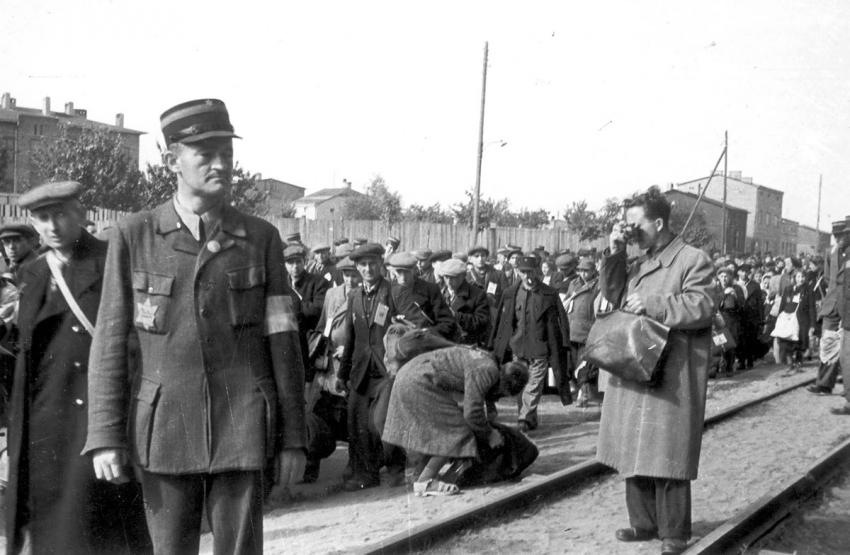About the Yad Vashem Photo Archive
"Mendel takes out his camera. No more flowers, clouds, nature, still lifes or landscapes. Amid the horror all around him, he has found his mission: to photograph and leave testimony of the enormous tragedy taking place before his eyes for future generations."
Thus describes Arieh Ben Menachem the essence of the work of the Lodz Ghetto photographer Mendel Grossman, in the book "A Photographer in the Lodz Ghetto". Arieh Ben Menachem was a photographer himself, and during the war he worked as Mendel Grossman's assistant. Unlike Grossman, who perished in April 1944 in a German labor camp, Ben Menachem survived the Holocaust, and thanks to him, hundreds of photographs that were taken in the Lodz Ghetto by the two men arrived at Yad Vashem.
Mendel Grossman's photographs are only a small portion of the collection of historical photographs preserved in the Yad Vashem Photo Archive. The origins of the collection lie in the documentation efforts of individuals and groups immediately after the end of World War II. Following the opening of the Yad Vashem Archives in 1955, the photographs that had been collected previously were incorporated into the Archives. In 1983, a separate photo section was set up, and since then, this section has coordinated the collection, cataloguing and research of historical photographs related to the Holocaust. In 1993, computerized cataloging of the collection was initiated, and in 1998, the scanning of the photographs began. In 2008, some of the database was uploaded to the Internet for the first time. The photographs in the Yad Vashem Photo Archive database constitute a priceless resource for historians, educators, writers, film producers and for all those in the general public who are interested in the subject of the Holocaust.
The photograph collection documents a variety of areas: Jewish life before and during the Holocaust; the lives of the survivors in Europe after the war; Holocaust commemoration activities around the world, and more. The photographs arrive at the Archives from a wide range of sources, including official archives, private collections, museums, various historical collections and other places.
In the database displayed here are approximately 150,000 historical photographs. Photographs with a copyright are displayed with the owners' permission, as well as photographs that may be uploaded without restrictions on the right to privacy.
The photograph database is presented here as a public service. It is the largest existing collection of photographs dealing with the subject of the Holocaust, and it can be seen as the realization of the legacy of the photographer Mendel Grossman.
About The Hall of Names Photo Collection
"I, too, had a face marked by rage and joy and compassion,
Quite simply - a human face!"
Benjamin Fondane, Exodus
Murdered at Auschwitz, 1944
Benjamin Fondane uses the word "face" as the mirror of a person’s identity, the face behind the name and the life story. The Hall of Names at Yad Vashem, which contains over 2.7 million Pages of Testimony, is meant to restore their names and even their faces to the Holocaust victims.
The Pages of Testimony are special forms created by Yad Vashem to reinstate their personal identity and briefly document the life stories of the six million Jews who were murdered by the Nazis and their accomplices. These one-page Pages of Testimony, submitted by survivors, family members or friends in memory of Jews murdered during the Holocaust, include names, biographical details and, when possible, even photographs, of each victim, and they have become a symbolic "monument" for each one. Since its establishment, Yad Vashem has tirelessly endeavored to fulfill its moral duty/commitment and remember each and every victim as a person, and not -as a number. The first 800,000 names on the Pages of Testimony were gathered in the 1950s, through continued efforts to this day to identify anonymous victims in order to memorialize them forever.
Until the present time, over 2,700,000 million names have been recorded on Pages of Testimony written in over 20 languages. They are stored in perpetuity in a circular repository around the walls of the Hall of Names. Many shelves remain empty, a silent witness to the millions of victims who have not yet been memorialized.
Sadly, most of the Holocaust victims identified by name at Yad Vashem did not leave a photograph of their faces behind them. Nevertheless, to date, 176,000 photographs have been attached to the Pages of Testimony, among them photographs of individuals or family and group photographs. Every month we receive hundreds of additional photographs from members of the public, family members, friends, acquaintances and researchers, thus expanding the Hall of Names photograph database.
Most of the photographs were taken before the war, memorializing men, women and children, Jews with dreams and hopes, with a whole life in front of them – this is how we should remember them.







